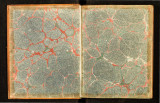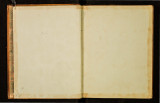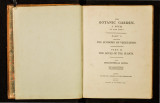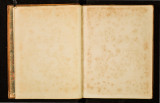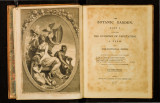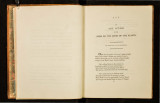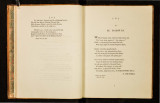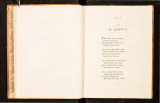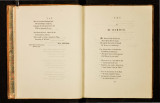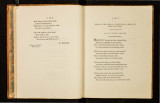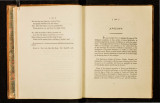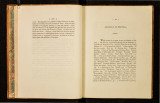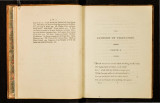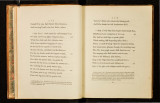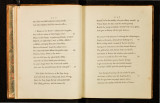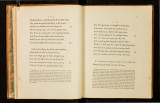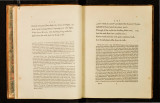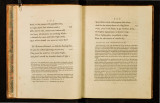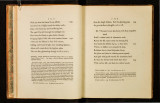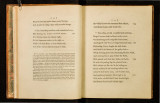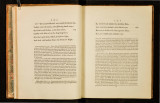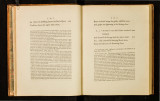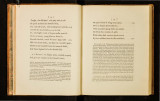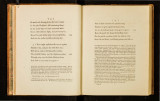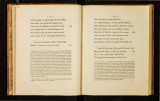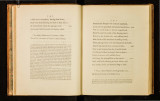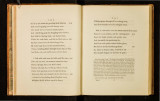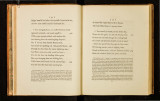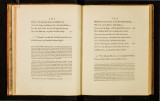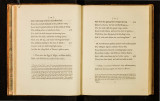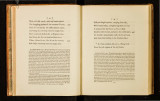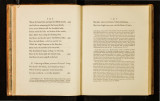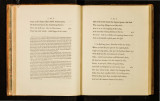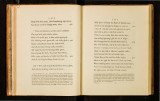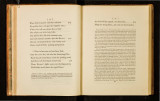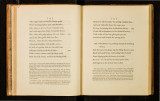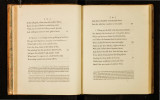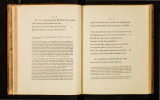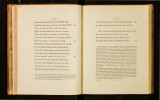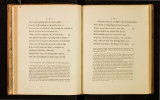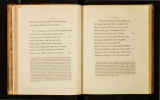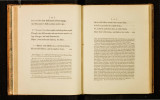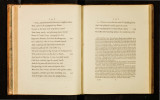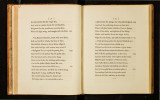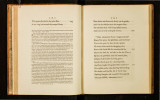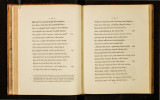| OCR Text |
Show 6o ) NOTE XXIII.-CO A L. Henct fable Coal his majfy couch extends, And Jlars of gold the Jparkling Pyrite blends. CANTO II. 1. 349· TO elucidate the formation of coal-beds I 01all here defcribe a.fournain of _fol1il tar,_ or petroleum, difcovered lately near Colebrook Dale in ShropOme, the particulars ot , which were fent me by Dr. Robert Darwin, of Shrewfbury. About a mile and a half below the celebrated iron-bridge, confl:ruClecl by the late C I b k Dale 011 the ~a(t fide of 1 he ri ver Severn 1 as the workmen Mr DARBY, near o e roo , . itL OCtober 1786 were making a fubterranean ~a nal into th~ mollntatn, for the. more €:af acquifition and conveyance of the coals which lie under It, th ey found an oozm~ _of . Y_d b" t oleum. and as they proceeded furth er cut through fmall cav1t1es hqUJ 1tumen, or per ' f h" of different flzes from which the bitumen i ffu ed. From ten to fifteen barre!s o t IS foJiil tar, each barrel containing thirty-two gallons, _were at firfl: collected ll1 a day, which has fince however gradually diminiilied in quantity, fo that at prefent the produtl: is about feve~ barrels in fourteen days. . . . · · 11·1ch this canal enters, confifl:s of fihceous fand, 111 wh1ch The mountatn, mto w · · oduttions apparently in their recent !late, have been found, however a tew manne pr ' d · the p·o{l'e"ion of Mr WILLIAM REYNOLDS, of Ketly Bank. About an are now 111 111 • . • 1 h d d ds from the entrance inno the mountam, and about t".-venty-e1ght yards t 1ree un re yar · l below the fmface of it, the tar is found oozing from the fand-rock above mto t 1e top-and fides of the canal. . B th the level of this canal a {haft has been funk through a grey argtllaceous-enea · · d. · fubflance, called in this country clunch, which is faid to be a prett_y certatn _w Jcattun of-coal; beneath this lies a ftratum of coal, about two or three mches th1ck, ~f. an inferior kind, yielding little flame in burning, and leaving much alhes ; below ~hts IS a . rock of a harder texture, and beneath this are found coals of an excell_ent qual1ty; for the purpofe of procuring which with greater facility the canal, or honzontal aperture, is now making into the mountain. July, 1788. . Beneath thefe coals in fome places is found fait water, in other parts of the adpce~t country there are beds of iron-flone, which alfo contain fome bitumen in a lefs fiu 1J {late, and which are about on a level with the new canal, into which the foffil tar ooze~, as above defcribed. · There are many intercfl:ing circumfl:ances attending the fituation and ac ompaniments of this fountain of foffil tar, tending to develop the manner of its produtl:ion. I. As the canal paffing into the mountain runs over the beds of coals, and under the refervoir of petroleum, it appears that a natural di)lillation of this fofl\1 in the bo:vel~ of _th.e ea_rth mu!t have taken place at fume early period of the world, ftmilar to tht! artt fic1 ;1l d1fl:llbuon NoTE XXIII. COAL. 61 of coal, which has many years been carried on in thJs place on a fmaHer fcafe above ground. When this refervoir of petroleum was cut into, the llowncfs of its exfudation into the canal was not only owing_ to its vilcidity, bot to the preffure of rhe atmofphere, or to the neceffity there was that a1r lhould at the fame time infinuate itfclf into the fmall cavities from which the petroleum defcemled. The exiflen ce of fuch a diflillation ~t fome antient time is co~firme~ by the_ thin flratum of coal beneath the cnnal, (whi ch covers the hard rock) havmg bewg depnved of its foffil oil, fo as to burn without flame, and thus to have become a natural coak, or foffil charcoal, while the petroleum dill.illed from it is found in the cavities of the rock above it. There are appearances in other places, which favour this idea of the natural dill.illation of petroleum, thus at Matlock in Derby{hire a hard bitumen is found adhering to the fpa: in the clefts of the lime-rocks in the form of round drops about the fize of peas; wh1ch could perh aps only be depofited there in that form by fublimation. 2. The fecond deduCtion, which 0ffers itfelf, is, that thefe beds of coal have been expojed to a c?'?fiderab/e degru of heat, fiuce the petroleum above could not be feparated, as far as we know, by any other means, and that the good quality of the coals beneath the hard rock was owing to the impermeability of this rock to the bituminous Yapour, and to its preffure being too great to permit its being removed by the elafticity of that vapour. Thus from the degree of heat, the degree of prelfure, and the p::rmeability of the fuperincumbent fl:rata, m.tny of the phenomena attending coal-beds receive an eafv explanation, which much accords with the ingenious theory of the earth by Dr. Hutto;1 Tranf. of Edinb. Vol. I. In fome c0al works the fufion of the fl:rata of coal has been fo light, that there remains the appearance of ligneous fibres, and the impreffion of leaves, as at T3ovey near Exeter, and even fe eds of vegetables, of which I have had fpecimens from the collieries near Polefworth in Warwicklhire. In fome, where the heat was not very intenfe and the incumbent fl:ratum not permeable to vapour, the foflll oil has only rifen to the t1pper part of the coal-bed, and has rendered that much more inflammable than the lower parts of it, as in the collieries near Beaudefert, the feat of the EARL OF UxnRmc E in Staffordlhire, where the upper flrat11m is a perfect cannel, or candle-coal, and rhe lower one of an inferior quality. Over the coal-beds near Sir H. HARPUR's houfe in Derby{hire a thin lamina of afphaltum is found in fome pl:ices near the fnrfncc of the earth, which woulcl feem to be from a dillillation of petroleum from the coals below, the more fluid part of which had in procefs of time exhaled, or been confolidated by its abforption of air. In other coal-works the upper part of the flratum is of a worfe kind 1han the lower one, as at Alfreton and Oenbigh, in DerbyOiire, owing to the fuperincumbent flratum having permitted the exhalation of a great part of the petroleum; whilfl: at Widdrington in Northumberland there is firfl a feam of coal about fix inches thick of no value, which lies under about four fathom of clay, beneatli this is a white frtefl:onc, then a hard fl:one, which the workmen there call a whin, then two fathoms of clay, then another white !lone, and under that a vein of coals three feet nine inches. |



